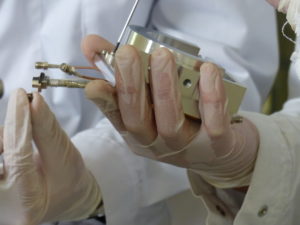Lunar Radon detectors under test at Arronax
Hosted for 4 days at the GIP ARRONAX, the Toulouse DORN team conducted a measurement campaign to qualify the detectors that will be sent to the Moon in 2024 aboard the Chinese probe Chang’E 6, to measure radon.
The DORN (Detection of Outgassing RadoN) project, led in France by IRAP (Institut de Recherche en Astrophysique et Planétologie) under the supervision of Cnes, aims to design and develop an instrument to measure the amount of radon gas escaping from the lunar surface by alpha spectrometry. This, in order to better understand what controls the concentration of this gas on the Moon’s surface. The radon detection system must be previously tested and calibrated in order to discriminate the signals due to alpha particles coming from the radon decay and those left by the solar wind and cosmic radiations.
This test phase of the ultra-thin detectors (thickness similar to that of a hair) took place in May 2022 thanks to the Arronax cyclotron whose high-energy beams allow to simulate the conditions of exposure to particles in space.

crédit photo : GIP ARRONAX
After a day and a half of installation on the Arronax beamline dedicated to research, Pierre-Yves Meslin, scientific leader of the DORN project, Vincent Thomas (post-doc), Damien Rambaud (electrical engineer), Wilfried Marty (software engineer) and Maxime Gault (intern) carried out a measurement campaign that allowed to qualify the response of the detectors to protons and alphas of several energies, and this for a wide range of incidence angles.
The data collected at Arronax will be compared with established simulations to validate the numerical model of the instrument. During these experiments, researchers and engineers of IRAP were also able to adjust the delay of coincidences between detectors and to verify the behavior of the device at high counting rates.
More information about DORN project
Contact : Charbel Koumeir, Noël Servagent

